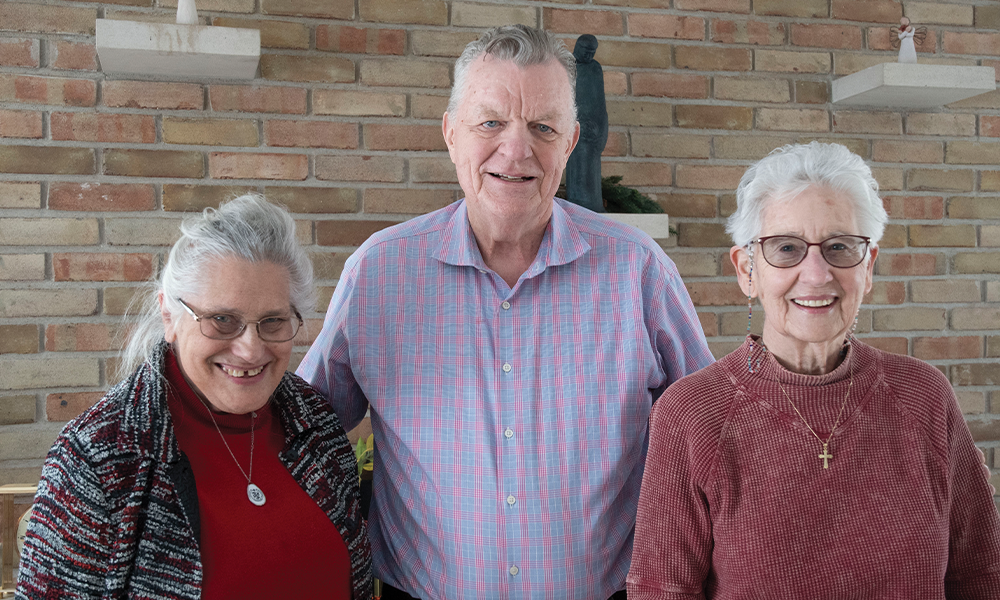
Finding God in the silence
When Ronnie Neumann’s husband died 33 years ago, she felt completely lost. Through the age-old Catholic practice of the Desert Fathers, contemplative prayer, she also found solace.
After 25 years of marriage, Ronnie somehow had to carry on with the Midland construction company, Alloy Construction Service, while mourning the loss of her husband, Bob. In the middle of juggling the demands of suddenly having to take over the business, Ronnie often would repeat Psalm 46:10 (“Be still and know that I am God”) over and over — especially in the first weeks after her husband’s death. Slowly, she would feel peace return.
But it was her practice of contemplative prayer that carried her through the grieving process. To this day, Ronnie makes contemplative prayer a daily practice, and prays with a small group of like-minded people once a month. Ronnie, who has been a member of the Order of Christian Initiation for Adults (OCIA) team at Holy Spirit Parish in Shields for more than 30 years, often introduces contemplative prayer, in addition to other prayer forms, to those wishing to become Catholic.
“I’ve always credited [contemplative prayer] with saving my life,” she said. “It’s kind of a dramatic way of putting it, but that’s what it felt like to me.”
People sometimes have the mistaken belief that contemplative prayer is only accessible to religious like cloistered nuns, monks and priests, said Gerry Bishop, who considers himself an “active contemplative” out in the world. But contemplative prayer is accessible to anyone, and Gerry has found it to be a lifesaving daily practice.
The former oncology social worker ran cancer and grief support groups for Covenant Medical Center— even while his wife Lisa battled pancreatic cancer. After Lisa lost her battle in 2009, Gerry continued to run the support groups until his retirement in 2021. Contemplative prayer gave Gerry the strength he needed to get through it all.
“There’s just no way I could have navigated all of that myself,” he said. “It kept me afloat.”
Now, Gerry leads a small group of people who meet every month to sit in silence and pray together. There is tremendous support, comfort and “communion without words” when people come together to pray contemplatively together.
The roots of contemplative prayer date back to the third century when Desert Fathers—hermits who practiced the earliest form of Christian monasticism—lived in the Egyptian desert. Through practices that included silence, fasting and reading Scripture, the Desert Fathers modeled Jesus’ life of poverty, service and self-denial, and they laid the foundation for the contemplative prayer tradition in the Catholic Church.
Contemplative prayer is often paired with lectio divina (“divine reading”), a form of meditation dating back to early monastic communities. It involves four stages: lectio (reading), meditatio (meditation), oratio (prayer) and contemplatio (contemplation).
By reading a short Scripture passage slowly, one meditates and focuses on a single word or phrase that touches the mind and heart. One then offers a prayer to God, and then by God’s grace enters contemplation.
By connecting to God in this way, “it gives us a deeper peace out of which to move,” said Leona Sullivan, founder of the Mustard Seed Shelter in Saginaw and a lifelong practitioner of contemplative prayer.
“One of the beautiful things about Catholicism is that we have a rich contemplative heritage,” she said.
Leona leans on her daily practice of contemplative prayer to strengthen her for the work that needs to be done in the homeless shelter for women that she founded nearly 30 years ago.
Leona— who first learned about the importance of an active prayer life by observing her mother— eventually joined the Home Visitors of Mary, a small religious community in Detroit. Leona left the order after about 30 years to live more in the margins so she could help others in the spirit of Servant of God Dorothy Day, the great servant of the poor in New York City.
Still, Leona makes contemplative prayer part of her daily life and gets together every month with a few others, including Gerry and Ronnie, to practice contemplative prayer.
“It sustains me,” Leona said. “The last thing I would ever give up is my daily quiet time of prayer.”
Gerry agrees that contemplative prayer is the foundation of his spiritual life. Each morning, he practices lectio divina, paying attention to the word or phrase that speaks to him through Scripture and asking “What is God calling me to?” As a response, he writes a prayer. And then he sits in contemplation “trusting in God’s quiet presence and action engaging my deepest being.”
Three days a week, Gerry also attends Mass where he receives the Eucharist “from a contemplative place.”
Following these daily spiritual practices, Gerry said he can be fully present to what each day brings.
“I feel like the quality of what I do is so much greater. It is a beautiful gift,” Gerry said. “I can give myself to each day, each person, so I can attune to what God is calling me to.”
Learn More About Contemplative Prayer
Introductory books
Fire Within and Prayer Primer: Igniting a Fire Within by Father Thomas Dubay
Spiritual classics
The Cloud of Unknowing, written anonymously in the 14th century
Dark Night of the Soul and Ascent of Mount Carmel by St. John of the Cross
Autobiography, The Interior Castle and The Way of Perfection by St. Teresa of Ávila
Revelations of Divine Love by Julian of Norwich
Read Dynamic Catholic’s guide to beginning lectio divina
Want to learn more about contemplative prayer?
What is contemplative prayer? (Aleteia)
The Church's official teaching on contemplative prayer
Pope Francis' catechesis on contemplative prayer
An introduction to contemplative prayer by Father Thomas Dubay
